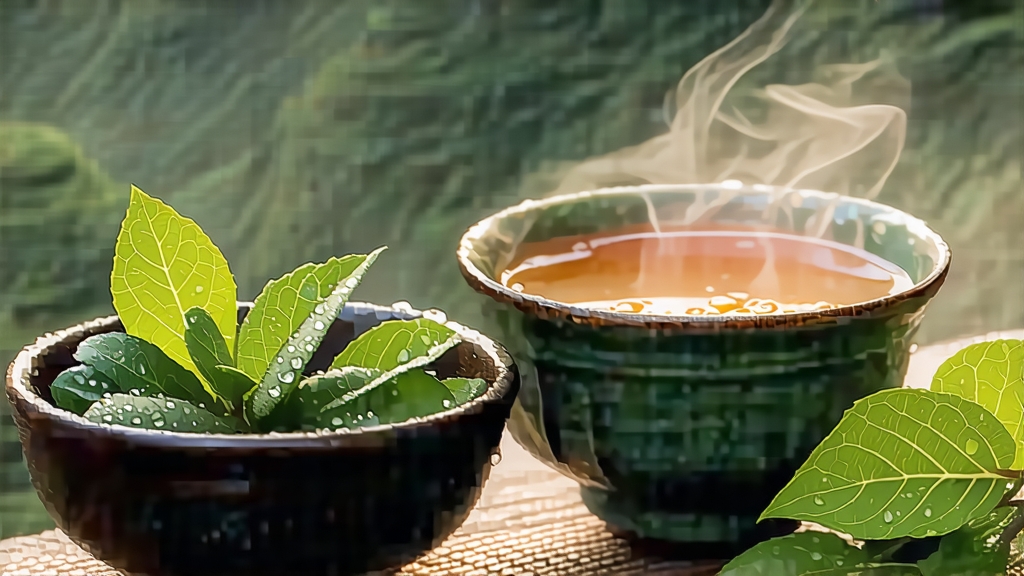
Alishan High-Mountain Oolong, known in Taiwan as “Alishan Qing Xiang Oolong,” is the island’s most celebrated gift to the global tea stage. Grown between 1,000 and 1,400 meters in the mist-locked ranges of Chiayi County, this tea marries Chinese oolong heritage with Taiwan’s unique island ecology, producing a cup that is simultaneously floral, creamy, and mineral-bright. For international drinkers who have met Tie Guan Yin or Da Hong Pao, Alishan offers a softer, high-altitude counterpoint—an invitation to taste clouds.
Historical Roots
Oolong technology migrated from Fujian to Taiwan during the mid-19th century Qing expansion. Farmers from Anxi and Wuyi carried tea seedlings and charcoal-firing skills across the strait, but it was not until the 1980s that Taiwanese agronomists deliberately pushed plantings upward, chasing the slow growth and concentrated aromatics that elevation provides. Alishan, already revered for its cypress forests and sunrise vistas, became the marquee name for this new “high-mountain” (gaoshan) genre. Today the appellation is legally protected; only leaves picked within the designated townships of Meishan, Zhuqi, Fanlu, and Alishan District may bear the label.
Cultivars and Micro-Terroir
The dominant cultivar is Qing Xin (literally “green heart”), a bush prized for its lilac nose and natural buttery texture. At altitude, Qing Xin yields smaller leaves, thicker cuticles, and higher amino acids, translating into a sweeter, more viscous liquor. Soils are acidic laterite rich in iron and aluminum, drained by frequent cloud precipitation; diurnal swings can exceed 15 °C, coaxing the plant to store aromatic precursors overnight. Farmers often intercrop with betel nut, bamboo, and indigenous orchids, creating a polyculture that discourages pests and perfumes the air.
Plucking Standard
The ideal harvest occurs four times a year, but the spring and winter flushes command premium prices. Two leaves and a bud are plucked when the top leaf has reached the size of a newborn’s fingernail—tender enough for amino sweetness, yet mature enough to survive the rigorous rolling ahead. Picking starts at dawn when mountain fog is still thick, ensuring minimal oxidation en route to the processing shed.
Crafting the Leaf: A 24-Hour Choreography
- Wilting: Baskets of leaves are placed on wire mesh in shaded breezeways for 60–90 minutes, reducing grassy volatiles.
- Solar Wither: Under late-morning sun, leaves are stirred every ten minutes for 30–45 minutes, initiating enzymatic oxidation. Masters watch for the “green shine” to dull into a matte jade—an indicator that cell walls are ready for bruising.
- Bruising & Oxidation: Leaves are tumble-tossed in bamboo drums for five cycles, each followed by 45-minute rest. Edge oxidation climbs to 20–25 %, less than darker oolongs but enough to turn leaf rims reddish-brown.
- Fixation: A 280 °C drum roast for three minutes halts oxidation, locking in a green center and floral top notes.
- Rolling: The hot leaves are wrapped in cotton cloth and compression-rolled in mechanical barrels, gradually tightening the cloth ball to extrude sap and twist leaves into hemispherical nuggets.
- Drying: Low-temperature ovens reduce moisture to 4 % over two hours.
- Charcoal Finish (optional): For “traditional taste” lots, a 60 °C binchotan charcoal bake lasting 6–8 hours adds chestnut depth and prolongs shelf life. Modern “light aroma” versions skip this step, preserving a pristine bouquet.
From Mountain to Mug: Brewing Protocol
Western ratio: 3 g per 250 ml, 90 °C water, 3 min first infusion.
Gongfu ratio: 6 g in 120 ml gaiwan, 95 °C, flash rinse, then 25 / 35 / 45 / 60-second steeps, adding five seconds each round until flavor fades.
Water wisdom: Use spring water below 80 ppm hardness; high calcium mutes the silky texture.
Vessel choice: A thin-walled porcelain gaiwan amplifies high notes, while a seasoned zisha teapot rounds the body and accentuates charcoal tones.
Tasting Lexicon